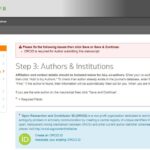Featuring updates to ICMJE recommendations, concerns surrounding APCs and quality control in open access journals, and the route to efficient data citation.
New year, new publication recommendations via ICMJE
The International Committee of Medical Journal Editors (ICMJE) bid farewell to 2018 with major updates to its publication recommendations. These include changes to the guidelines on preprints and data sharing, and they are available as an annotated PDF. The updated recommendations call for enhanced responsibility of authors for ensuring transparency in choosing a preprint server and for making any necessary amendments to link preprints to subsequent versions of their publication. Authors are also required to provide clear statements on patient data sharing, indicating if deidentified patient data will be shared with ‘undecided’ no longer being a viable option. Finally, the guidelines suggest that journals should place less emphasis on impact factor and instead provide a range of metrics more relevant to both authors and their target audience.
Are diamond journals a researcher’s best friend? via Khrono
Article publishing charges (APCs) associated with gold open access journals constitute a deeply problematic issue surrounding Plan S. Although sometimes covered by funding bodies, APCs are still expected to be paid by the authors themselves. With Plan S providing very few details on funding for open access publishing, there are some concerns that the plan’s implementation may lead to an economy built entirely on APCs, which will subsequently prevent a considerable number of authors from publishing. The article also calls into question the quality control of open access journals, with discrepancies seen between commercial and non-profit journals. In contrast to gold open access journals, diamond open access journals are free to both read and publish in, with costs being covered by a third party such as the Max Planc Institute for Demographic Research which provides financial support to Demographic Research. If third-party funding could be ensured by Plan S, diamond journals could answer both financial and quality control concerns.
The path to efficient data citation via The Scholarly Kitchen
In the past, tracking citations was a lengthy process. However, thanks to efforts from organizations such as ORCID and Crossref, this has now been made a lot easier and faster. Despite the progress made in literature tracking, the existence of a wide range of global data repositories makes linking data sets to publications more challenging. To help publishers align with the Findable, Accessible, Interoperable and Reusable (FAIR) Data Principles, FORCE11 has published a road map breaking down the key steps in efficient data citation. The document includes guidelines on appropriate data repositories, correct data set tagging and how to ensure data sets are included within the publishers’ feed to Crossref. Following this path will ensure that there are links to all data sets – a practice that will greatly benefit the scientific community.
The next step in preprints via Outbreak Science Blog
Scientific publishing is a time-consuming process with authors often experiencing a significant delay between manuscript submission and publication. To speed up this process, many authors now choose to publish their work as preprints, thus making data freely and immediately accessible to the scientific community and to the general public. Although most preprint servers allow commenting there is no way for scientists to share structured feedback with the authors. A new collaboration between Outbreak Science and PREreview, which is supported by the Wellcome Trust, hopes to address this issue by building a new system that will enable the rapid review of preprints. In addition to the preprints themselves, the reviewers’ comments will also be made immediately accessible to increase research transparency.






